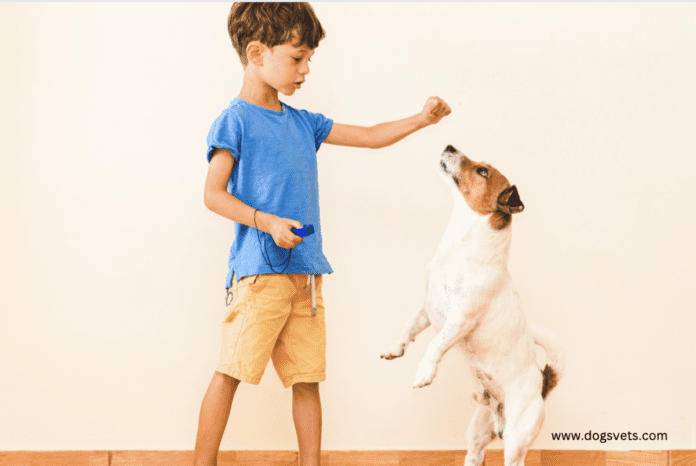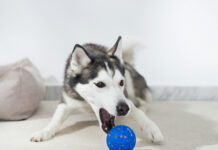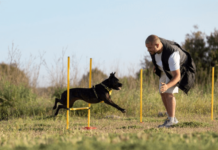Last Updated on January 13, 2023 by Dogs Vets
How to train with a dog clicker
Are you looking for a fun and effective way to train your dog? learning how to train with a dog clicker make your job a lot more easier.
What is a Clicker and How Does it Work?
A dog clicker is a small, handheld device that makes a clicking sound when pressed. It is often used in dog training as a way to communicate with a dog and mark desirable behaviors.
A clicker, also known as a training clicker, may be just what you need.
In this guide, we’ll cover everything you need to know about using a clicker to train your dog, including how to get started, common mistakes to avoid, and some helpful tips and tricks.
It’s often used in the process of “clicker training,” which is a type of positive reinforcement training that involves rewarding desired behaviors with a click and a treat.
The click serves as a marker, letting the dog know that they did something right and a reward is coming. This helps the dog understand exactly which behavior is being rewarded, which can make training more effective and efficient.
Why is a dog clicker helpful for training?
A dog clicker is helpful for training because it allows for precise communication with a dog.
It can also help a dog learn faster because it allows the trainer to mark the exact moment a desired behavior is performed.
How do I introduce a dog clicker to my dog?
To introduce a dog clicker to your dog, start by charging the clicker, which means pairing the click sound with treats.
Give your dog a treat immediately after clicking the clicker. Repeat this process several times until your dog starts to associate the click sound with a reward.
How to Get Started with Clicker Training
To get started with clicker training, you’ll need a few things: a clicker, treats, and a quiet space to work in.
It’s also a good idea to have a basic understanding of how positive reinforcement training works, as this will be the foundation of your training.
Here’s a step-by-step guide to getting started with clicker training:
- Introduce the clicker: Start by simply clicking the clicker and immediately giving your dog a treat. Do this a few times to get your dog accustomed to the sound of the clicker and the fact that it means a treat is coming.
- Choose a behavior to work on: Next, decide on a behavior that you want to train your dog to do. This could be something simple like sitting or lying down, or something more advanced like retrieving an object or performing a trick.
- Click and treat: Once you’ve chosen a behavior to work on, wait for your dog to perform the behavior and then immediately click and treat. Repeat this process several times until your dog is consistently performing the behavior.
- Fade the treats: As your dog becomes more proficient at the behavior, you can start to fade the treats and rely more on the clicker as a reward.
You can do this by gradually decreasing the frequency of treats, or by using a clicker and a treat together for a while and then switching to just the clicker.
Common Mistakes to Avoid
While clicker training is a relatively simple process, there are a few mistakes that you’ll want to avoid to ensure that your training is effective:
- Not clicking and treating immediately: It’s important to click and treat as soon as your dog performs the desired behavior. If you wait too long, your dog may not understand what they’re being rewarded for.
- Clicking and treating for the wrong behavior: Make sure you’re clicking and treating for the behavior you want to reinforce, not for something else that your dog is doing.
- Not using high-value treats: If your dog isn’t motivated by the treats you’re using, they may not be as interested in training. Use treats that your dog loves to help keep them engaged.
- Not paying attention to your dog’s body language: Pay attention to your dog’s body language during training. If they seem stressed or anxious, take a break and try again later.
Tips and Tricks for Successful Clicker Training
- Start with simple behaviors: It’s best to start with simple behaviors when you’re first getting started with clicker training. This will help your dog understand and learn better.
- Practice regularly: To ensure that your dog is making progress, it’s important to practice regularly. Set aside a few short training sessions each day, and gradually increase the difficulty as your dog improves.
- Be patient: Training takes time, and it’s important to be patient with your dog. If they’re having trouble with a particular behavior, take a break and try again later.
- Use a variety of treats: To keep your dog motivated, mix things up by using a variety of treats during training. This can help prevent boredom and keep your dog engaged.
- Use the clicker consistently: It’s important to use the clicker consistently during training. If you only use it sometimes, your dog may become confused and may not understand what they’re being rewarded for.
- End each training session on a positive note: To keep your dog motivated and engaged, it’s important to end each training session on a positive note. This can be as simple as letting your dog play with their favorite toy or giving them an extra-special treat.
Questions People are Asking
- Can clicker training be used for any dog, regardless of breed or age?
Yes, clicker training can be used for any dog, regardless of breed or age.
However, it may be more difficult to train older dogs if they have not been exposed to training before, as they may be set in their ways. In these cases, it may be helpful to consult with a professional trainer.
- Is clicker training the only way to train a dog?
No, clicker training is just one method of training a dog.
There are many other methods, including positive reinforcement training, operant conditioning, and punishment-based training.
The best method for you and your dog will depend on your goals, your dog’s personality, and your comfort level with different training techniques.
- How long does it take to train a dog using a clicker?
The length of time it takes to train a dog using a clicker will vary depending on the dog, the behavior being trained, and the amount of time and effort you put into training.
Some dogs may learn quickly and easily, while others may take longer to grasp the concepts.
In general, it’s important to be patient and to give your dog plenty of positive reinforcement and rewards as they learn.
- Do I need to use treats during every training session?
Treats can be an effective way to reward your dog for good behavior, but they don’t have to be used during every training session.
As your dog becomes more proficient at a particular behavior, you can gradually decrease the frequency of treats and rely more on the clicker as a reward.
It’s also a good idea to use a variety of treats to keep things interesting for your dog.
- Can I use a clicker to train my dog to do tricks?
Yes, you can use a clicker to train your dog to do tricks. In fact, clicker training is a great way to teach your dog more advanced behaviors and tricks.
Just be sure to break the behavior down into smaller steps and reward each step with a click and a treat.
- Can I use a clicker to train my dog to do obedience commands?
Yes, you can use a clicker to train your dog to do obedience commands. Start by teaching your dog basic commands like “sit” and “stay,” and then gradually add more advanced commands as they become proficient.
Remember to reward good behavior with a click and a treat, and be patient as your dog learns.
7. How do I use the clicker effectively during training?
To use the clicker effectively during training, it is important to be consistent with the clicking sound and to time the click correctly.
The click should be made immediately after the desired behavior is performed, as this will help the dog understand which behavior is being rewarded.
8. Are there any mistakes to avoid when using a dog clicker?
Some common mistakes to avoid when using a dog clicker include clicking too late, using the clicker as a punishment, and clicking too often.
It is also important to avoid using the clicker as a replacement for treats or other rewards.
9. Can I use a dog clicker for any type of training?
A dog clicker can be used for a wide range of training exercises, including obedience training, agility training, and behavior modification. It is a versatile tool that can be used to teach a variety of behaviors.
10. Are there any advanced training techniques that can be used with a dog clicker?
Yes, there are several advanced training techniques that can be used with a dog clicker, such as shaping and chaining behaviors.
Shaping involves reinforcing a dog for small steps towards a desired behavior, while chaining involves teaching a dog to perform a series of behaviors in a specific order.
11. How long does it take for a dog to learn to respond to a dog clicker?
The amount of time it takes for a dog to learn to respond to a dog clicker can vary depending on the individual dog and the training goals.
Some dogs may learn to associate the clicker with a reward after just a few training sessions, while others may take longer.
It is important to be patient and consistent when training with a clicker, and to use positive reinforcement to encourage desired behaviors.
12. Is it okay to use a clicker to train my dog to stop unwanted behaviors?
While a clicker can be effective in reinforcing desired behaviors, it’s not typically used to stop unwanted behaviors.
Instead, it’s usually more effective to use a combination of positive reinforcement and negative punishment to stop unwanted behaviors.
For example, if your dog is jumping on people, you could use positive reinforcement to reward them for four paws on the ground, and negative punishment to ignore or remove the reward (such as a toy or attention) when they jump.
It’s important to consult with a professional trainer if you’re having trouble with unwanted behaviors, as the best approach will depend on the specific behavior and your dog’s individual needs.
13. Do I need to use treats every time I use the dog clicker?
It is generally recommended to use treats or other rewards in combination with the dog clicker to help reinforce the behavior being trained.
However, as the dog becomes more familiar with the clicker and the training process, treats may be phased out and other rewards, such as toys or praise, can be used in their place.
14. Is a dog clicker the only tool I need for training?
A dog clicker can be a helpful tool for training, but it is not the only tool that may be needed. Other training aids, such as leashes, collars, and toys, may also be used depending on the specific training goals.
It is also important to consider the individual needs and personality of the dog being trained, and to use a variety of training techniques and approaches as needed.
I hope this guide on training with a dog clicker has been helpful!
Clicker training is a fun and effective way to train your dog, and with a little patience and practice, you can teach your dog a wide range of behaviors and tricks.
Fact Check
We hope you enjoyed reading this article. What are your thoughts on the topic?
“At [Dogsvets.com], our goal is to bring you the most accurate and up-to-date information on all things pet-related.
If you have any additional insights or would like to advertise with us, don’t hesitate to get in touch.
If you notice any errors or discrepancies in our content, please let us know so we can correct them.
We welcome your feedback and encourage you to share this article with others.”

















